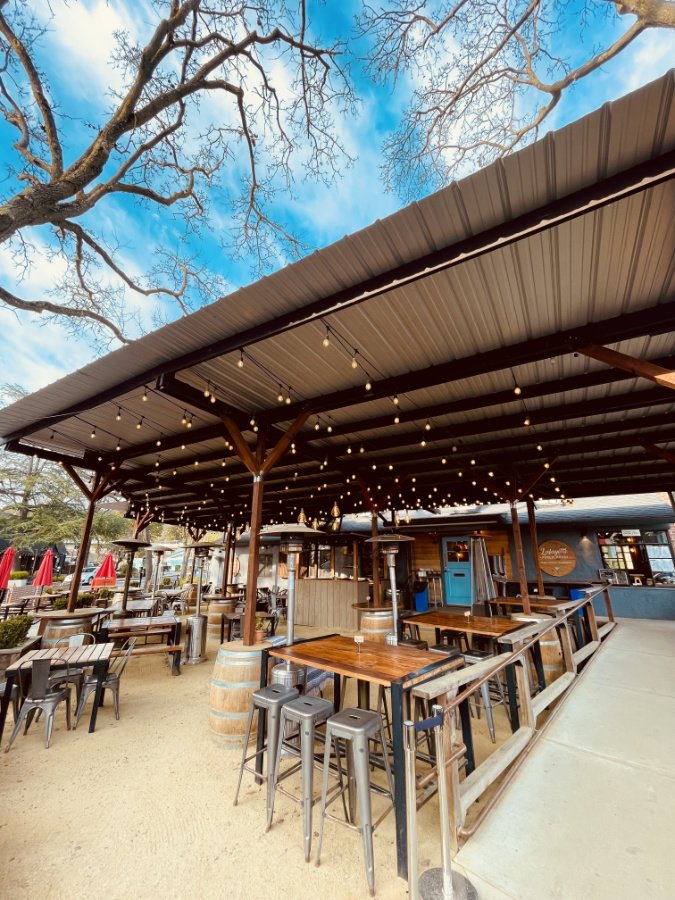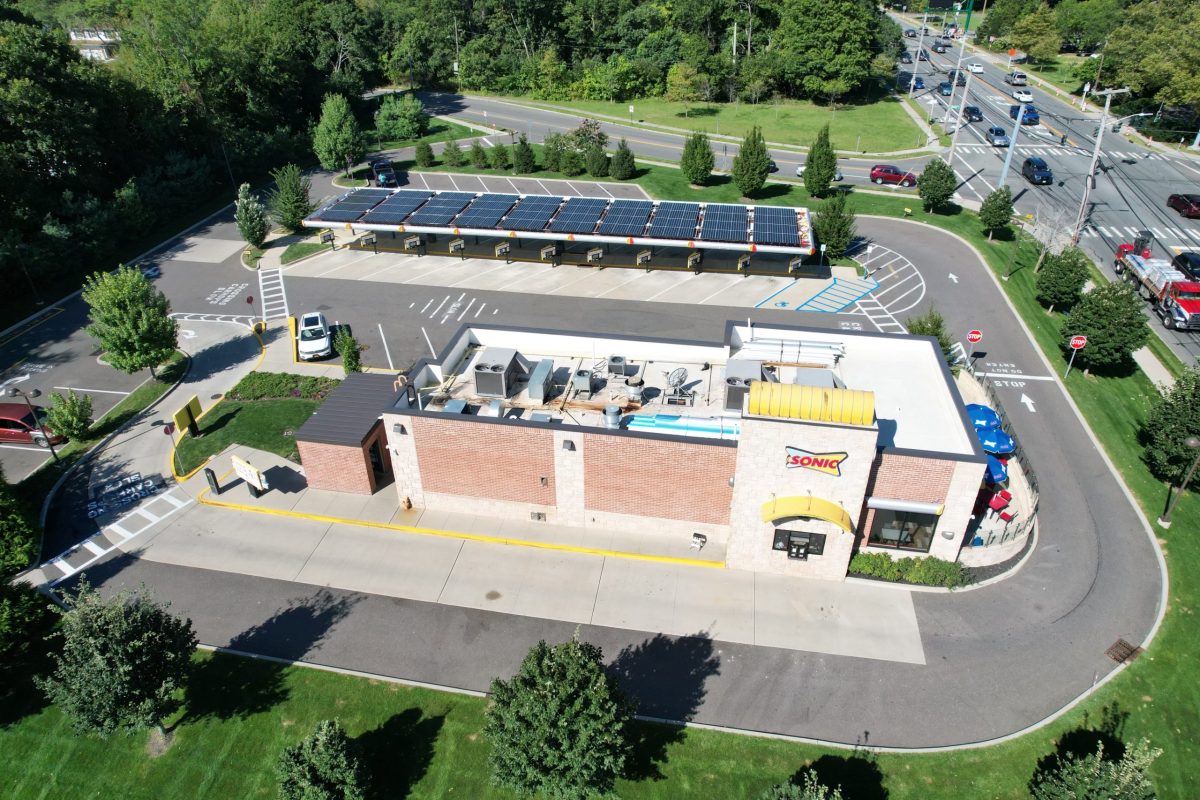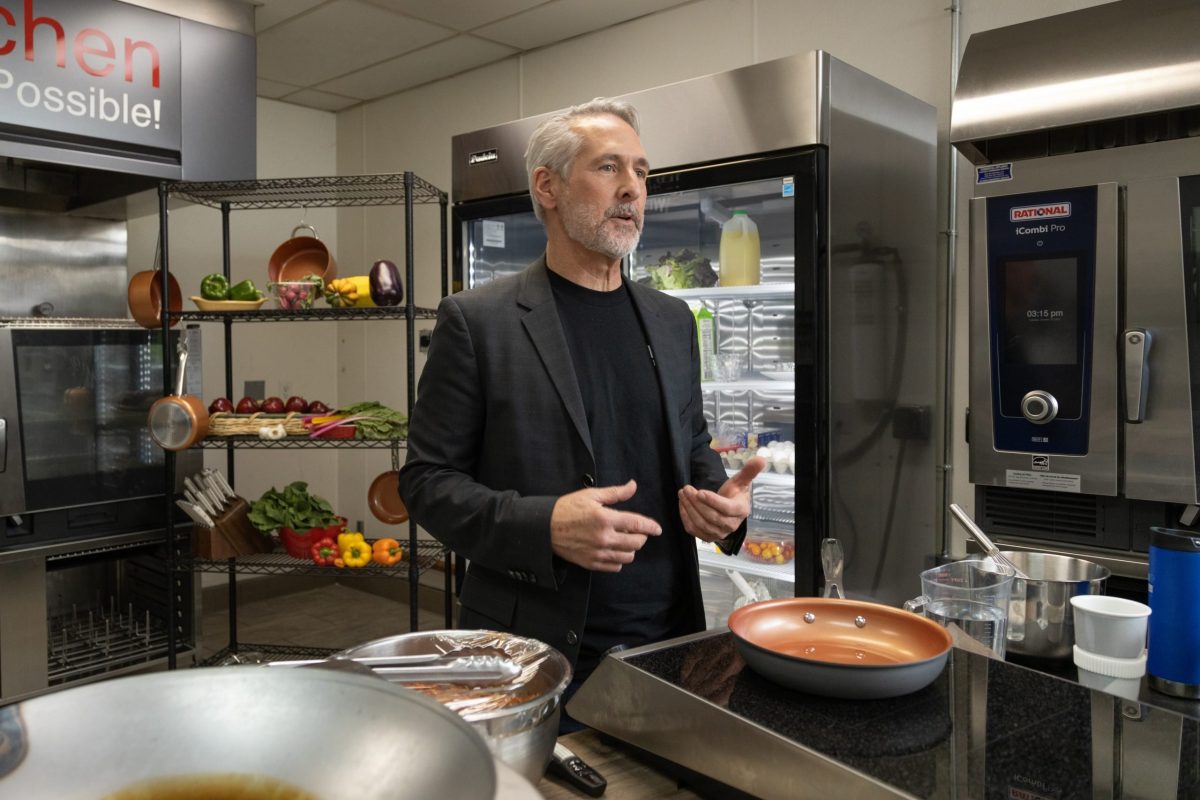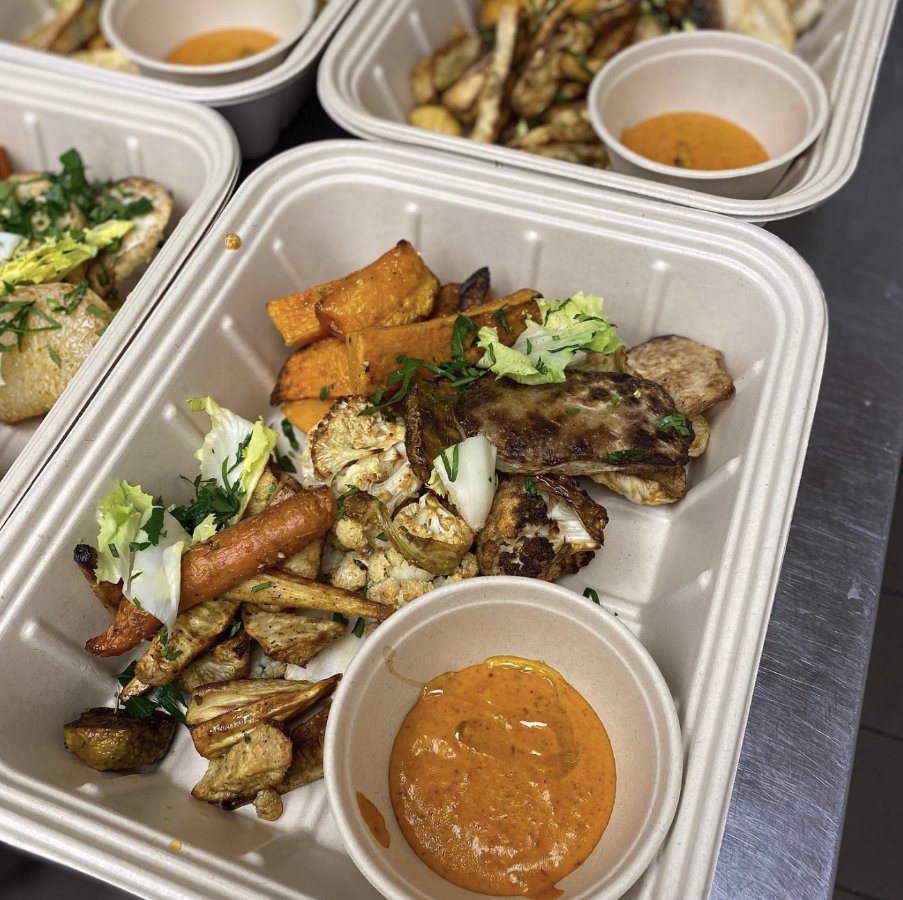Cooking, refrigeration, air conditioning, water use, and packaging contribute to greenhouse gas emissions, too. These restaurants try to tackle them all.

Cooking, refrigeration, air conditioning, water use, and packaging contribute to greenhouse gas emissions, too. These restaurants try to tackle them all.
October 15, 2024

Illustration by Ellie Krupnik.
This is the fourth article in a five-part series about restaurants and climate-change solutions, produced in collaboration with Eater.
Expand your understanding of food systems as a Civil Eats member. Enjoy unlimited access to our groundbreaking reporting, engage with experts, and connect with a community of changemakers.
Already a member?
Login
Rifrullo Café, a cozy farm-to-table restaurant in Brookline, Massachusetts, hums with customers on a steamy July mid-morning. Patrons sip coffee on the shady sidewalk patio. Inside, people hunch over laptops or chat with friends, waiting for Turkish poached eggs with harissa-spiced eggplant or cinnamon custard French toast.
Rifrullo’s rustic-modern décor, mismatched dishware, and chalkboard sign welcoming guests to “be yourself, make friends, find harmony, and relax,” are as inviting as its prices, which top out at $16 for the salmon burger. Chef-owner Colleen Marnell-Suhanosky opened the restaurant in 2013 after working for renowned Boston chef Lydia Shire and at various East Coast restaurants, including Gramercy Tavern in New York City.
“Community, environment. It’s part of my DNA . . . As a chef, I have a responsibility to do my best to create good environments for people, customers, and the community,” says Marnell-Suhanosky.
As part of creating that good environment, she’s taken multiple steps to cut Rifrullo’s carbon footprint, including composting all food scraps, one of the most important steps restaurants can take to combat climate change. When food waste goes to landfills, it creates methane, a powerful greenhouse gas. Food waste from all sources is responsible for eight percent of global greenhouse gas emissions, and the U.S. produces the equivalent annual emissions of 42 coal-fired power plants.
But restaurants have other, less visible sources of waste that also contribute to climate change. These include energy (used for cooking, refrigeration, heating, and cooling), water, and packaging. Food service buildings in the U.S., including restaurants, annually use a total of 365 trillion BTUs of electricity (still generated mainly from fossil fuels) and gas. That’s equal to the carbon emissions of about 110,611 gasoline-powered cars (using the Environmental Protection Agency’s greenhouse gas calculator).
They also use 15 percent of the water consumed by commercial buildings in the U.S., and that use is tightly linked to energy consumption. Inefficient dishwashers, for example, waste both energy and water. Moreover, restaurants and food services use nearly 1 trillion pieces of disposable food service ware and packaging annually, according to a report from Upstream, an agency that advocates for the reuse industry.
Commercial kitchens use anywhere from two to 10 times more energy per square foot than other commercial businesses, Richard Young, the director of Frontier Energy, a national energy consulting firm, told Civil Eats.
Heating and cooling, refrigeration, and cooking equipment are the biggest energy users, followed by lighting. There’s no rule of thumb for how much energy a certain type of restaurant might use, Young said. “Two burger restaurants that look the same can have really different energy use depending on how they cook the burgers.” A chain-style charbroiler, for instance, can use up to four times more energy than a griddle. Location also matters: A restaurant in a hot climate like Texas will use more air conditioning than a restaurant in Brookline, Massachusetts.
Rifrullo Café’s Marnell-Suhanosky switched from gas to an energy-saving electric resistance oven four years ago and very recently installed an induction cooktop. The kitchen is now fully electric.
Induction ovens and cooktops produce, on average, about half the greenhouse gas emissions (GHG) of gas cookers, though that figure varies according to how clean the source of electricity is.
“It’s just been a game changer,” she said. “It’s much cleaner. We could not expel the fumes that would come off the gas stove and the filth that it creates.”
Induction ranges (electric ovens equipped with induction cooktops) produce on average about half the greenhouse gas emissions (GHG) of gas cookers, though that figure varies according to how clean the source of electricity is, Young said. An induction range powered entirely by renewable energy, for example, would produce zero GHG emissions. Induction ranges are safer to use because there is no open flame. They’re also easier to clean and don’t produce radiant heat, which keeps kitchens cooler. But they can cost three to four times more than gas units. Plus, many cooks prefer cooking with gas for its precise and rapid heat control and the ability to blister certain foods, like chiles, directly in the flame.
The California Restaurant Association, in fact, joined forces with a state gas utility, SoCalGas, to recently beat back a 2019 Berkeley ordinance banning natural gas in all new buildings, even though the rule wouldn’t have affected existing restaurants. The association argued that its members favored gas cooking, and that the ordinance would limit their options when opening new locations.

Lafayette Public House, in Lafayette, California, has largely switched to induction cooking. (Photo courtesy of Lafayette Public House)
Not all California restaurateurs agree.
“We’re very open to induction. It’s a great tool for our overall success,” said Emily Lyall, operations manager at the Lafayette Public House, a coffee, bar, and kitchen. Lyall purchased two induction ranges for her California restaurant. Though the restaurant still uses one gas range, Lyall said they run it just two to three times a week and designed their menus to do without it.
Advocates worry that the same forces that took down the California gas ordinance are setting their sights on Massachusetts, where Brookline and nine other communities have banned gas appliances in new buildings, as has New York State and more than 100 cities and counties across the country.
Several chains, including Chipotle and McDonald’s, are already experimenting with creating all-electric kitchens powered by renewable energy. The greater Boston vegetarian chain Clover Food Lab has largely electrified its 13 locations with induction ranges and fryers.
And while it takes training and time to adjust to induction cooktops, Young said that in his experience, “it typically takes people about two days to fall in love with it, and then they don’t want to give it up.”
That seems to be the case with Rifrullo’s kitchen staff. As cook Luz Sanguna finishes preparing an order of huevos rancheros, she says the induction cooktop is “much better,” because it cooks more quickly and “doesn’t burn.”
“I wish I would’ve done it a long time ago,” Marnell-Suhanosky says.
Cooking equipment is just one facet of restaurant energy use. Refrigerators and heating, ventilation and air conditioning (HVAC) units can consume enormous amounts of energy.

Solar panels on a Sonic restaurant in Long Island, NY, provide 35 to 40 percent of the restaurant’s electricity needs. Budderfly provided the upfront capital for the installment. (Photo courtesy of Budderfly)
“There’s about a 30 percent waste factor going on out there,” said Al Subbloie, founder and CEO of Connecticut-based Budderfly, a company that helps restaurants and other businesses reduce their energy costs.
Budderfly provides restaurants with the upfront capital to purchase newer, more energy-efficient equipment, including lighting, refrigeration controls, thermostats, heat pump technology, induction ovens—even solar panels. Budderfly manages the utility bills free of charge, and when electricity costs drop, it shares those savings with the restaurant. Typically, restaurants receive three to six percent of the savings, and “End up with an economic benefit handed to them for nothing,” said Subbloie. “I removed the friction of doing the right thing.”
Budderfly’s business model works best for restaurants with longevity, since its contracts are for 10 years, or for chains, whose multiple locations use large amounts of energy. For example, it helped Sonic burger franchise owner Spencer Hart install solar panels on the drive-in canopies at four of his Long Island locations. Those panels now provide 35 to 40 percent of his electricity needs. Budderfly also installed a new HVAC system at one location and made other equipment upgrades that have cut his energy use by 20 percent.
The HVAC system would have cost Hart tens of thousands of dollars, he said. “We got a share of the savings, and we didn’t put up anything, and it’s good for the world.” Hart now wants to install EV chargers at his Sonic locations.
Frontier Energy also helps restaurants improve their energy efficiency, though it doesn’t provide upfront capital for equipment. And new equipment is often beyond the reach of small restaurants.

Richard Young of Frontier Energy teaches restaurateurs about induction cooking. (Photo courtesy of Frontier Energy)
“We really try to work with mom-and-pops, but they are called ‘hard-to-reach customers,’ because they’re busy trying to survive,” said Young.
Chef Edward Lee, owner of three restaurants in Louisville, Kentucky and Washington, D.C., agrees. “I don’t know a single chef or restaurateur who wants to be wasteful, but at the end of the week, if you’re running a small independent restaurant, you don’t have the time, the energy, the resources, to figure it out,” he said.
Unfortunately, he adds, “if you are a smaller restaurant . . . you’re probably buying the cheapest fryer you can get, and that low-cost fryer is going to cost you two to three times more to operate then the higher-cost fryer that the chain restaurant down the street from you is purchasing.”
Independent restaurants can get help through utility energy audit and equipment rebate programs—if their state has them. Marnell-Suhanosky, for example, got a free audit from her electric utility, which installed LED light bulbs, and a shutoff valve on her walk-in refrigerator that turns the cooling system on only when the temperature gets too high. “It’s been a big energy saver,” she said. She also got rebates for the induction ovens.
About 16 states offer restaurants rebates for purchasing energy-efficient equipment, according to Young. Frontier Energy runs California’s program, which knocks $1,000 off a $5,000 four-burner induction cooktop. California’s Energy Wise website also provides efficiency ratings for 3,500 pieces of commercial restaurant equipment, design guides, cost calculators, and online classes that are available to restaurateurs in any state.
Restaurants can also be very water intensive, between the hand sinks, pre-rinse stations for the sanitizing dishwashers, and the dishwashers themselves.
“It’s amazing how much water can go through a quick-service restaurant, or an Asian restaurant with woks, which use enormous amounts of water,” said Young. The best way to cut water use is through energy-efficient equipment, he said—even simple changes, like installing a low-flow pre-rinse spray valve on a faucet. “We started a huge giveaway program in California where we gave away tens of thousands of pre-rinse spray valves because it saved so much water.”
Marnell-Suhanosky has taken small steps to decrease her water use. Regulars at her restaurant, who are members of the nonprofit climate advocacy group Mothers Out Front, helped her put gaskets on all her water faucets, preventing leaks.
Lyall at Lafayette Public House has also taken steps, training the staff to fully load the dishwasher before running it. “In a restaurant setting, when you’re constantly running your water 12 hours a day, little steps like that, and better training for our staff, can go a long way in helping with water efficiency.”
Plastics pollute in numerous ways, killing sea creatures, contaminating our food and permeating human bodies as tiny particles. They also contribute significantly to climate change. Plastics are 99 percent derived from fossil fuels, in what is typically a very energy-intensive process. The entire manufacturing cycle—from oil and gas drilling to petroleum refining to the production of plastics—creates greenhouse gas emissions. Plastics manufacture is in fact overtaking cars as the fastest-growing use of oil.
Marnell-Suhanosky does not sell plastic-packaged food or drink. For takeout, she uses compostable containers and wooden silverware. She also offers her customers a reusable container option called Recirclable, which provides durable plastic containers that customers can borrow like a library book and return at any participating restaurant. There’s no cost for the container. Customers simply need to download an app and return the container within two weeks.
Environmental experts say that moving from single use to reuse is one of the biggest opportunities for reducing plastic pollution, and it is slowly gaining momentum in restaurants and institutional kitchens around the country. Containers cost more upfront, but businesses start to save fairly quickly.

Clover Food Lab, in Boston, serves all of its meals in 100-percent compostable containers. Eighty percent of its meals are takeout. (Photo credit: Meg Wilcox)
Customers are slower to engage, however. “It takes a lot of education. People don’t quite understand it,” Marnell-Suhanosky said, adding that her game plan is to first get her regular customers on board through lots of dialogue, and hope that the practice takes off. Those conversations are important: A similar reuse program in Oakland recently failed due to customer confusion and logistical challenges.

Rifrullo uses plant fiber-based compostable containers from Good Start, a company based in New Hampshire. (Photo courtesy of Rifrullo Café)
Reuse systems also work best when they are readily and widely available to customers. Some chain restaurants are therefore starting to collaborate with other restaurants to scale up reusable container programs at the city level. In Petaluma, California, for instance, Starbucks helped create an experimental reusable to-go cup program. Called the Petaluma Reusable Cup Project, it involves eight Starbucks stores as well as dozens of restaurants and coffee shops across the city.
Other chains, such as Chipotle, are reducing plastics by switching to compostable takeout containers, which are made at least partially from plant materials and are designed to break apart in a commercial compost facility. Compostable containers are are an imperfect solution, however, because the U.S. composting infrastructure is patchy at best—and it’s not clear that compostable materials, which contain chemical additives like their plastic counterparts, are safe for recycling back into soil.
Boston’s Clover Food Lab has long used only compostable serviceware at its 13 locations, according to Senior Vice President Christopher Anderson. But, he said, “we have philosophical debates [about packaging] every day, especially as trends shift.”
Anderson questions whether a plastic container—which might be recyclable—is preferable to a compostable container, given that many people don’t have access to commercial compost facilities. “Ultimately, I think reductionism is the best thing possible, like getting into reusable bottles and silverware.”
For Marnell-Suhanosky, kitchen staples packaged in plastic are an even bigger headache. “I struggle with it. Mayonnaise, soy sauce in bulk, it all comes in plastic. She doesn’t have time to source alternatives, she said.
Lee faces the same problem. “But what if we told our purveyors, we will not accept food deliveries that are wrapped in single-use plastic? Can we actually create systems with reusable bags to ship meat, fish, poultry, and produce?”
In fact, Lee plans to push for such change through an experimental nonprofit restaurant he’s launching in Washington, D.C., this October, in collaboration with a local university. The restaurant, called Shia, will strive to be a zero-gas, zero-plastics kitchen that will test different sustainability practices and share its learnings with other small, independent restaurants.
“We’re going to work towards waste-reduction models based on what we think of as practical solutions for restaurants. There are solutions, but they exist on an industrial level—not practical for the average restaurant.”
Lee, who launched multiple initiatives to help restaurant workers during the COVID pandemic, said he now wants to turn to helping restaurants survive this next transition period [and] “build a bridge to the restaurant of the future.”
“Part of our goal is to convince, inspire, create dialogue, and get some of these generational, legacy restaurants to change the way of thinking that shapes their models.”
Such an initiative could be hugely beneficial to restaurateurs like Marnell-Suhanosky, who have little time to figure out which sustainability initiatives are the most cost-effective.
“It could keep me up at night if I let it, [worrying about] waste control and landfills” and climate change, she said. “But I have to remember . . . every little bit adds up to larger change. The more and more that we chefs work together on this, people will start to see it as the norm.”

July 30, 2025
From Oklahoma to D.C., a food activist works to ensure that communities can protect their food systems and their future.
Like the story?
Join the conversation.